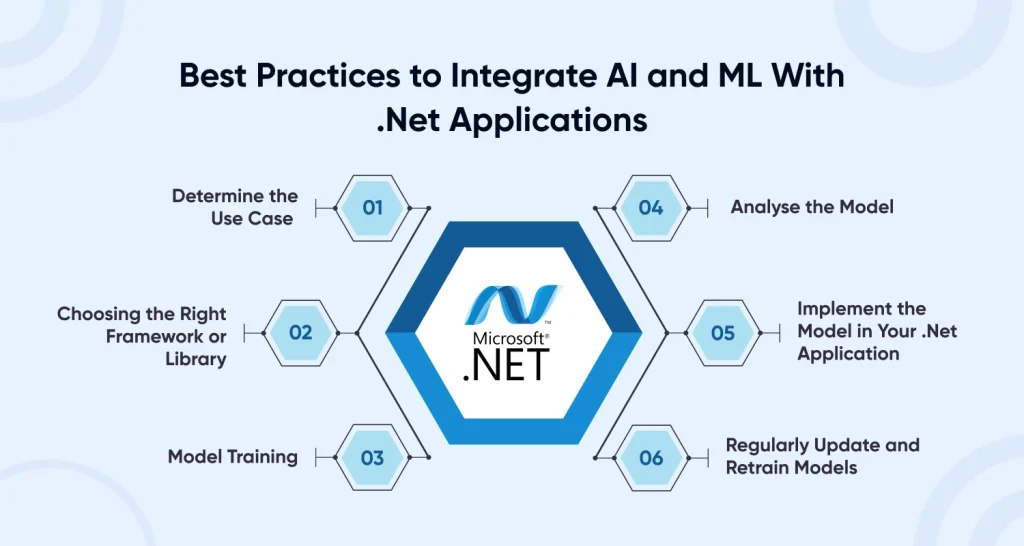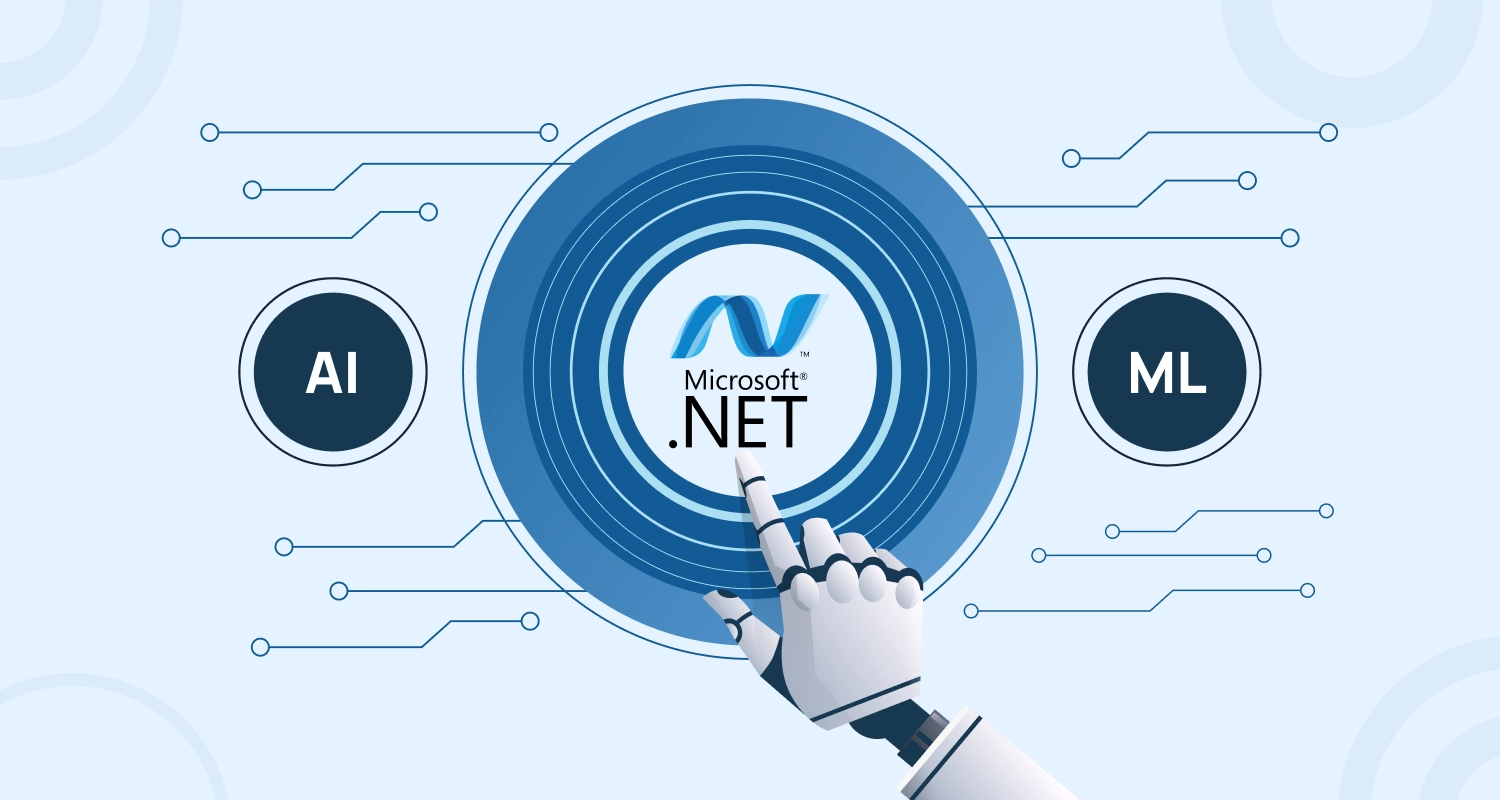Machine learning and artificial intelligence (AI) are becoming increasingly crucial to our digital lives. Adding AI and machine learning to .NET and other corporate applications makes an organisation more efficient. Enterprises can face many challenges as they compete in business environments, which can negatively impact their productivity and growth. Organisations are pressured to manage massive amounts of data and provide personalised service. This is why integrating AI and ML with .NET Applications can transform your business process.
The .NET platform has held a prestigious reputation among business professionals for over two decades. Websites using ASP.NET make up 6.8% of all websites. The reasons for its relevance in the development world are top notch security, unparalleled speed and greater scalability. With AI-driven .NET applications, organisations are addressing changing dynamics and reducing operational gaps using ML models.
Businesses are always striving to gain a competitive edge. This is where AI and ML integration make a crucial choice. To integrate AI and ML capabilities into a .Net application, you should hire ASP.NET developers. This blog discusses the integration of AI and ML with .NET applications and the benefits it offers.
What Makes Integrating AI and ML in .Net Applications an Ideal Choice?
With ASP.NET development services, organisations can automate workflows, enhance customer experiences, and gain insightful data analysis. This helps businesses to gain productivity and efficiency. These are some of the reasons why .NET apps should integrate AI and machine learning.
Efficiency and Accuracy Improved
One of the reasons that makes integrating AI and machine learning services an ideal choice is that it can automate repetitive tasks, ease your decision-making, and identify insights and patterns in large datasets. This brings in better accuracy than you experience with the manual process.
Analytical Predictions
With AI and machine learning in .NET applications, companies better understand customer behaviour and make wise business decisions. Taking the complete leverage of technology, businesses can prepare for the challenges and get ready for the actions using predictive insights.
Mitigating Cyber Attacks
The most crucial benefit of implementing AI and ML with .NET applications is that it adds a level of security in place and prevents cyberattacks. This allows businesses to add in internal security applications that are effective and efficient. By integrating ML models in .NET, businesses can analyse the behaviour of potential attackers and security threats. The .NET development company then leverages this insight to strengthen security measures autonomously.
Automating Procedures
With AI and machine learning, you can streamline repetitive, error-prone, and time-consuming digital and physical operations. As a result, employees can focus on other high-priority projects, thereby increasing output.
Best Practices to Integrate AI and ML With .Net Applications

To integrate AI or machine learning into .NET applications, there are several steps involved, including:
Determine the Use Case
The first step is identifying the problem you want to solve with AI and ML. By doing this, you will be able to identify the type of algorithm or model to use and the type of data you will need to train the algorithm.
Choosing the Right Framework or Library
Now comes the most crucial part of integration: choosing a reliable framework or library. A long list of dominating frameworks includes TensorFlow, PyTorch, and ML.NET. AI for .Net developers that you have onboard can choose from the framework list and get on track to easily solve the challenging problem. The choice of tool is based on the expertise of the developers.
Model Training
After preparing your data and choosing a tool or library, you can start training the AI or ML model. A predictive model is a software program that uses the available data to produce new predictions or make decisions based on the new input data.
Analyse the Model
To evaluate the accuracy and performance of the model, you need to train it first. Identifying issues and areas for improvement will help you ensure the model is working properly.
Implement the Model in Your .Net Application
Embedding an AI or machine learning model in your .NET application will yield robust and accurate results. By using APIs or libraries, a prediction or decision can be made based on new input data.
Regularly Update and Retrain Models
It is imperative that machine learning and artificial intelligence models are updated and retrained regularly to ensure their accuracy. Generally speaking, it is essential to consider the following when integrating AI and ML into your .NET applications:
- Technical skills.
- The preparation and analysis of data.
- The ability to continuously improve them.
The .NET framework provides developers an easy way to integrate AI and machine learning capabilities into their applications, providing a comprehensive platform to build and deploy AI/ML applications.

Leading AI and ML Libraries and Frameworks to Integrate With .Net Applications
Several AI and ML libraries and frameworks are compatible with .NET, but which one you should choose depends on the needs of your project, such as the AI feature or ML model you intend to implement.
Below are a few of the best AI and machine learning libraries and frameworks you can use to integrate AI in website and.NET applications:
TensorFlow
With TensorFlow, businesses and developers can easily build effective machine-learning models with a high accuracy rate. TF.NET, or TensorFlow.NET, holds top-notch capabilities that make implementing ML and AL with .NET applications easy.
With this top-notch framework to the rescue, you can conveniently create, launch, and train ML models.
CNTK (Cognitive Toolkit)
CNTK, or Cognitive Toolkit, is a unified toolkit for displaying neural networks that Microsoft developed. It is possible to develop applications with ease with feedforward DNS, convolutional nets, and recurrent networks. The open-source application provides deep learning capabilities for .NET applications and is suitable for commercial use.
Accord .NET
As a .NET Machine Learning platform, Accord .NET provides a multitude of tools for processing audio and images. It allows developers to incorporate AI, hand-eye coordination, computer vision, signal processing, and statistics into their .NET applications. As a result, AForge.NET and the API provided a single platform to build machine learning models.
PyTorch
The PyTorch deep learning framework combines scalability and adaptability. AI and Machine Learning in .NET applications are made more stable and easier with this framework. Since it integrates high-level technologies like Tensor Computation and NumPy into a Python package, it can be used to create dynamic machine learning algorithms.
LightGBM
This module belongs to Microsoftâs DMTK project, an open-source, highly effective gradient boosting system (GBDT). Integrating machine learning tools into your applications allows you to develop and deploy several different machine learning models, such as classifiers, ranking algorithms, and much more. The LightGBM framework lets developers create models that function as classification, regression, or deep learning systems.
Dlib
The Dlib toolkit contains numerous machine learning algorithms and other tools required to create complicated C++ software that handles a variety of business challenges.
ONNX
This open-source machine learning framework format, called Open Neural Network Exchange (ONNX), enables the representation of important machine learning models. ML .NET creates prediction models in C# .NET Core console applications.
Uses of AI and ML With .Net Applications
Taking a Proactive Approach to Maintenance
Many industries integrate AI and machine learning into their .NET applications to achieve predictive maintenance. By collecting data, evaluating it, and forecasting upcoming failures, the ML model evaluates data. With this information, you can take action on the current problems and implement procedures to fix them when they arise.
Providing Customer Service
Customer service can be improved by using .NET apps that incorporate AI and Machine Learning capabilities. Using it, you can track customer conversations in real-time. To aid customer service agents and anticipate future client needs, .NETs analyse speech patterns, language, and psychographic profiles.
Processing of Images and Videos
It has been reported recently that several companies have developed .NET apps that use deep learning to improve CNN models. Businesses can enhance their image quality by combining artificial intelligence and machine learning with .NET software. Further to producing better segmentation, encoding, decoding, and manipulation, AI and machine learning may also be utilised.
Conclusion
Tools and technology used to construct apps constantly change in Application software development. Integrating AI and ML into NET applications is the perfect way for businesses to register growth and top leading software development trends. It can benefit both corporations and individuals. Artificial intelligence (AI) and machine learning are capable of automating repetitive tasks, facilitating workflows, and displaying insights into the predictive implications of AI.
However, when you implement AI and ML in .NET applications, it can enhance productivity by automating data entry, allowing resources to focus on other tasks. AI and ML can promote corporate growth by increasing the effectiveness, productivity, and efficiency of .NET applications.
Frequently Asked Questions
1. Can AI and Machine Learning Boost Enterprise Efficiency with .NET Apps?
Companies have the best time enhancing productivity and efficiency by implementing AI and ML g into .NET apps. With this, businesses can automate and optimise workflows, boosting customer experiences and getting a glimpse into the business data.
2. What Is the Best Way to Integrate AI Into Your App?
There are certain steps to integrate AI into your business applications. It starts with understanding your business goals, selecting the framework, etc.
3. Is It Possible to Integrate AI and Machine Learning into .Net Applications?
Yes, we can integrate AI and machine learning into dot NET applications. Additionally, .NET provides many tools, libraries, and frameworks for developing machine learning and artificial intelligence applications.
4. How can .Net Apps Be Enhanced with AI and ML Using Microsoft Libraries?
Microsoft has new AI and machine learning capabilities for devices and cloud environments. Using .NET libraries compatible with AI and ML, these pre-built models can be used with Core ML or built from scratch.
5. Why should .Net Applications Integrate AI and ML?
Using it has several benefits, both for businesses and end users. Artificial intelligence and machine learning enhance performance, automate routine tasks, streamline workflows, and provide predictive insights. AI in .NET enhances users’ experiences and allows data to be analysed in real-time.
